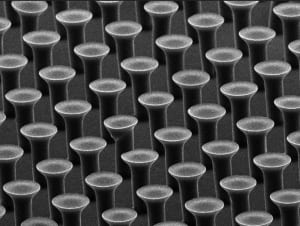A dry adhesive technology inspired by the microscopic hairs on gecko’s feet is said to be the first of its kind to be commercialized. Known as Setex, the technology was developed by nanoGriptech Inc. (Pittsburgh, Pa.; www.nanogriptech.com), a company spun out of Carnegie Mellon University, and uses no chemicals and leaves no residue.
The adhesive consists of a structured surface containing millions of nano-scale elements shaped like tiny hairs with widened tops (see micrograph). When the nano-hairs come into close contact with another surface, van der Waals interactions (dipole-dipole attractions) act to adhere the nanostructures to the surface. The nano-hairs work via the same principles observed in the adhesion of microscopic, hair-like structures called setae on the surface of a gecko’s feet.
The company adapted processes initially developed for other industries to manufacture templates for the nanoscale surface structures in the adhesive, explains Paul Glass, nanoGriptech’s vice president for engineering. Then the template is used to produce the nanostructured surface out of various polymers. The proprietary process modifies the nanostructures for improved adhesion, and a wide range of materials can be used to construct the surface structures and its substrate.
NanoGriptech offers films of its materials in one- and two-sided versions for use in a wide range of applications. Glass says the material can allow for new functionality in a number of areas, so many uses are still being explored. For example, Glass points out that Setex is being used to seal chemical and biological protective suits used by the U.S. Army, and is being investigated for use in industrial gripping applications for high-value glass, as well as in automotive seating and for various uses in the apparel industry.
